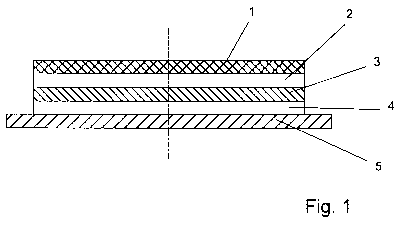Some of the information on this Web page has been provided by external sources. The Government of Canada is not responsible for the accuracy, reliability or currency of the information supplied by external sources. Users wishing to rely upon this information should consult directly with the source of the information. Content provided by external sources is not subject to official languages, privacy and accessibility requirements.
Any discrepancies in the text and image of the Claims and Abstract are due to differing posting times. Text of the Claims and Abstract are posted:
| (12) Patent Application: | (11) CA 2689933 |
|---|---|
| (54) English Title: | SELF-ADHESIVE ANTENNA FOR AN RFID SYSTEM, IN PARTICULAR AN RFID LABEL, AND METHOD FOR THE PRODUCTION THEREOF |
| (54) French Title: | ANTENNE AUTO-COLLANTE POUR SYSTEME RFID, EN PARTICULIER POUR ETIQUETTE RFID, ET SON PROCEDE DE REALISATION |
| Status: | Deemed Abandoned and Beyond the Period of Reinstatement - Pending Response to Notice of Disregarded Communication |
| (51) International Patent Classification (IPC): |
|
|---|---|
| (72) Inventors : |
|
| (73) Owners : |
|
| (71) Applicants : |
|
| (74) Agent: | SMART & BIGGAR LP |
| (74) Associate agent: | |
| (45) Issued: | |
| (86) PCT Filing Date: | 2008-06-04 |
| (87) Open to Public Inspection: | 2008-12-11 |
| Examination requested: | 2013-03-26 |
| Availability of licence: | N/A |
| Dedicated to the Public: | N/A |
| (25) Language of filing: | English |
| Patent Cooperation Treaty (PCT): | Yes |
|---|---|
| (86) PCT Filing Number: | PCT/EP2008/004432 |
| (87) International Publication Number: | WO 2008148527 |
| (85) National Entry: | 2009-12-01 |
| (30) Application Priority Data: | ||||||
|---|---|---|---|---|---|---|
|
The invention relates to a self-adhesive antenna for an RFID system, in
particular an
RFID label, wherein, according to the invention, the antenna (1), from a sheet
of
aluminum (7) of a gauge of 1 µm - 20 µm, in particular approximately 10
µm, is glued to
the front of an adhesive material (3) and punched out, wherein an adhesive
layer (4) is
provided on the back side of the adhesive material (3).
La présente invention concerne une antenne auto-collante destinée à un système RFID, en particulier à une étiquette RFID, l'antenne (1) étant selon l'invention réalisée par collage à partir d'un film d'aluminium (7) ayant une épaisseur de 1 µm - 20 µm, en particulier d'environ 10 µm sur le côté avant d'une matière adhésive (3), et matriçage, la matière adhésive (3) présentant sur son côté arrière une couche d'adhésif (4).
Note: Claims are shown in the official language in which they were submitted.
Note: Descriptions are shown in the official language in which they were submitted.

2024-08-01:As part of the Next Generation Patents (NGP) transition, the Canadian Patents Database (CPD) now contains a more detailed Event History, which replicates the Event Log of our new back-office solution.
Please note that "Inactive:" events refers to events no longer in use in our new back-office solution.
For a clearer understanding of the status of the application/patent presented on this page, the site Disclaimer , as well as the definitions for Patent , Event History , Maintenance Fee and Payment History should be consulted.
| Description | Date |
|---|---|
| Inactive: Dead - No reply to s.30(2) Rules requisition | 2016-03-02 |
| Application Not Reinstated by Deadline | 2016-03-02 |
| Deemed Abandoned - Failure to Respond to Maintenance Fee Notice | 2015-06-04 |
| Inactive: Abandoned - No reply to s.30(2) Rules requisition | 2015-03-02 |
| Change of Address or Method of Correspondence Request Received | 2015-01-15 |
| Inactive: S.30(2) Rules - Examiner requisition | 2014-08-28 |
| Inactive: Report - No QC | 2014-08-27 |
| Letter Sent | 2013-04-08 |
| Request for Examination Requirements Determined Compliant | 2013-03-26 |
| Request for Examination Received | 2013-03-26 |
| All Requirements for Examination Determined Compliant | 2013-03-26 |
| Inactive: Cover page published | 2010-02-12 |
| Inactive: Notice - National entry - No RFE | 2010-02-12 |
| Inactive: IPC assigned | 2010-02-10 |
| Inactive: First IPC assigned | 2010-02-10 |
| Application Received - PCT | 2010-02-10 |
| National Entry Requirements Determined Compliant | 2009-12-01 |
| Application Published (Open to Public Inspection) | 2008-12-11 |
| Abandonment Date | Reason | Reinstatement Date |
|---|---|---|
| 2015-06-04 |
The last payment was received on 2014-05-23
Note : If the full payment has not been received on or before the date indicated, a further fee may be required which may be one of the following
Please refer to the CIPO Patent Fees web page to see all current fee amounts.
| Fee Type | Anniversary Year | Due Date | Paid Date |
|---|---|---|---|
| Basic national fee - standard | 2009-12-01 | ||
| MF (application, 2nd anniv.) - standard | 02 | 2010-06-04 | 2010-05-21 |
| MF (application, 3rd anniv.) - standard | 03 | 2011-06-06 | 2011-05-25 |
| MF (application, 4th anniv.) - standard | 04 | 2012-06-04 | 2012-05-24 |
| Request for examination - standard | 2013-03-26 | ||
| MF (application, 5th anniv.) - standard | 05 | 2013-06-04 | 2013-05-23 |
| MF (application, 6th anniv.) - standard | 06 | 2014-06-04 | 2014-05-23 |
Note: Records showing the ownership history in alphabetical order.
| Current Owners on Record |
|---|
| BIELOMATIK LEUZE GMBH + CO. KG |
| Past Owners on Record |
|---|
| MARTIN BOHN |